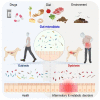Domestic Environment and Gut Microbiota: Lessons from Pet Dogs
- PMID: 35630391
- PMCID: PMC9143008
- DOI: 10.3390/microorganisms10050949
Domestic Environment and Gut Microbiota: Lessons from Pet Dogs
Abstract
Accumulating data show the involvement of intestinal microbiota in the development and maintenance of numerous diseases. Many environmental factors influence the composition and function of the gut microbiota. An animal model subjected to the same environmental constraints that will allow better characterization of the microbiota-host dialogue is awaited. The domestic dog has physiological, dietary and pathological characteristics similar to those of humans and shares the domestic environment and lifestyle of its owner. This review exposes how the domestication of dogs has brought them closer to humans based on their intrinsic and extrinsic similarities which were discerned through examining and comparing the current knowledge and data on the intestinal microbiota of humans and canines in the context of several spontaneous pathologies, including inflammatory bowel disease, obesity and diabetes mellitus.
Keywords: animal model; dogs; domestic environment; gut microbiota; holobiont; microbiome; pets.
Conflict of interest statement
The authors declare no conflict of interest.
Figures




References
-
- Alessandri G., Milani C., Mancabelli L., Mangifesta M., Lugli G.A., Viappiani A., Duranti S., Turroni F., Ossiprandi M.C., van Sinderen D., et al. Metagenomic Dissection of the Canine Gut Microbiota: Insights into Taxonomic, Metabolic and Nutritional Features. Environ. Microbiol. 2019;21:1331–1343. doi: 10.1111/1462-2920.14540. - DOI - PubMed
-
- West C.E., Renz H., Jenmalm M.C., Kozyrskyj A.L., Allen K.J., Vuillermin P., Prescott S.L., in-FLAME Microbiome Interest Group The Gut Microbiota and Inflammatory Noncommunicable Diseases: Associations and Potentials for Gut Microbiota Therapies. J. Allergy Clin. Immunol. 2015;135:3–13. doi: 10.1016/j.jaci.2014.11.012. - DOI - PubMed
Publication types
Grants and funding
LinkOut - more resources
Full Text Sources

